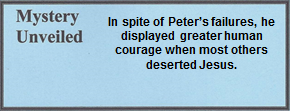15.03.09 Mt. 26:73-74a; Jn. 18:26-27a
PETER DENIES JESUS AGAIN
Mt. 73 After a little while those standing there approached and said to Peter, “You certainly are one of them, since even your accent gives you away.” 74a Then he started to curse and to swear with an oath, “I do not know the man!”
Jn. 26 One of the high priest’s slaves, a relative of the man whose ear Peter had cut off, said, “Didn’t I see you with Him in the garden?”
27a Peter then denied it again.

While Jesus was on trial, Peter was denying Him. The first denial appears to have occurred at midnight and the denial was given in a casual and simple manner. The second denial was probably at 3:00 a.m. at which time Peter swore under oath that he did not know Jesus. Obviously, his emotional pressure was intensifying. Sometime thereafter someone recognized him by his accent at which time he cursed Jesus. This detail is preserved in the Greek language, but is often lost in translation.[1]
“Your accent gives you away.” There was a strong difference in dialect between Jerusalem and Galilee. In fact, the Aramaic language spoken in Galilee, a/k/a Galilean Aramaic, was a branch of Middle Western Aramaic and clearly different from the Aramaic of Jerusalem.[2] Scholars believe this was due, in part, to the many Jews who returned from Babylon and settled in the province of Galilee in the second century B.C. When Ezra and Nehemiah returned from Babylon, there is no mention (in the books of Ezra and Nehemiah) of anyone settling in Galilee or Perea, only in the tribal areas of Judah and Benjamin as well as in Jerusalem. By the first century, the difference of voice inflections was so significant that some priests from Galilee were not permitted to speak words of blessing in the temple because their pronunciation of the gutturals was misleading.[3] The following comment refers to priests from three northern towns. In this quotation, the purpose of a priest lifting his hands was for pronouncing a blessing. This ark was not the lost Ark of the Covenant, but a piece of furniture called an “ark” in which the Torah scroll was kept.
A priest from Haifa or Beth Shean should not lift up his hands. It has been taught to the same effect; ‘We do not allow to pass before the ark either men from Beth Shean or from Haifa or from Tib’onim because they pronounce alif as ‘ayin and ‘ayin as alif…. If you were a Levite, you would not be qualified to chant, because your voice is thick.
Babylonian Talmud, Megillah 24b
The gospel narrative gives a great deal of difficulty to critics who claim that this gospel is a fabrication, because Peter is shown to be a coward and liar. The once brave man, who was willing to die for Jesus in the Garden of Gethsemane, now denied Him repeatedly. He could not be placed in a more degrading light than he is portrayed by Matthew and John. No creative fabricator would have placed the hero in this position. When examining the Pseudepigrapha books, the heroes are always individuals who were victimized by others but never guilty of their sins (i.e. Testament of the Patriarchs). In the gospels, Peter is one of the central figures in the life of Christ and has a reputation of making embarrassing comments, hasty decisions and, in this case, the ultimate sin of denying knowledge of Jesus. The gospel writers were determined to record the truthfulness of the events, no matter how shameful one individual or another would appear. Peter, no doubt, was very much alive when this was written, yet after the resurrection, his life was profoundly changed (see Acts). This account, which reveals some of the failures of the disciples, is another Testament to the accuracy of the gospel writers.
[1]. Fruchtenbaum, The Jewish Foundation of the Life of Messiah: Instructor’s Manual. Class 24, page 9.
[2]. Cohen, “Galilean Aramaic: Its Linguistic and Historical Significance.” 53.
[3]. Lightfoot, A Commentary on the New Testament from the Talmud and Hebraica. 1:168-69, 171.